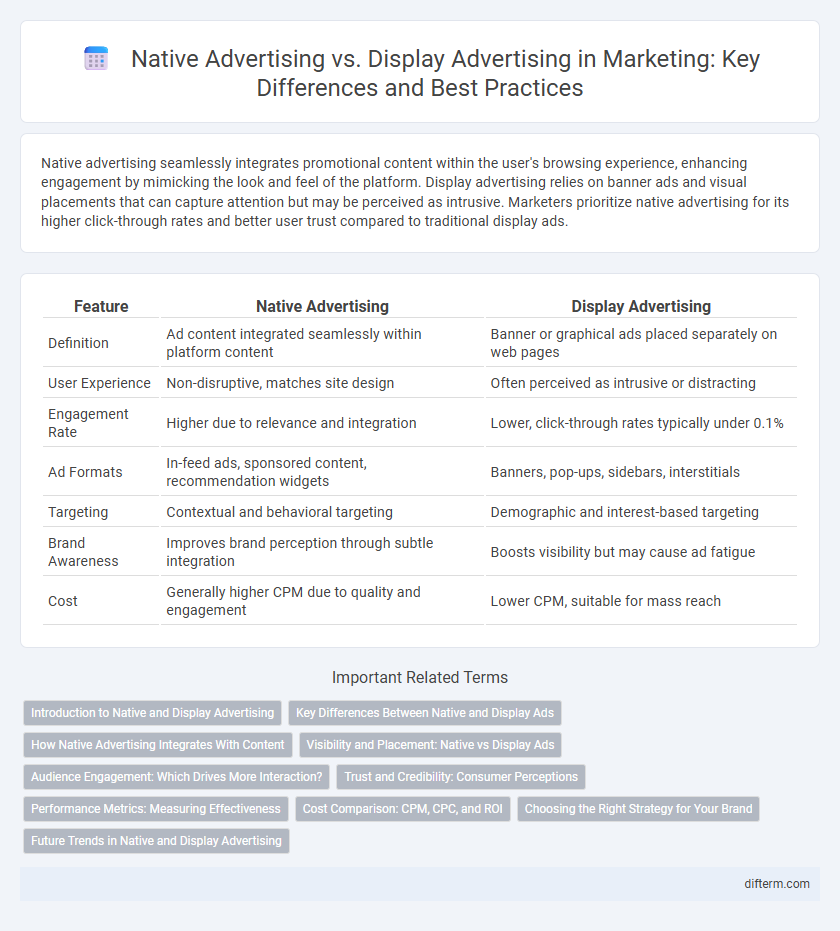Native advertising seamlessly integrates promotional content within the user's browsing experience, enhancing engagement by mimicking the look and feel of the platform. Display advertising relies on banner ads and visual placements that can capture attention but may be perceived as intrusive. Marketers prioritize native advertising for its higher click-through rates and better user trust compared to traditional display ads.
Table of Comparison
| Feature | Native Advertising | Display Advertising |
|---|---|---|
| Definition | Ad content integrated seamlessly within platform content | Banner or graphical ads placed separately on web pages |
| User Experience | Non-disruptive, matches site design | Often perceived as intrusive or distracting |
| Engagement Rate | Higher due to relevance and integration | Lower, click-through rates typically under 0.1% |
| Ad Formats | In-feed ads, sponsored content, recommendation widgets | Banners, pop-ups, sidebars, interstitials |
| Targeting | Contextual and behavioral targeting | Demographic and interest-based targeting |
| Brand Awareness | Improves brand perception through subtle integration | Boosts visibility but may cause ad fatigue |
| Cost | Generally higher CPM due to quality and engagement | Lower CPM, suitable for mass reach |
Introduction to Native and Display Advertising
Native advertising seamlessly integrates promotional content within the user experience, matching the look and feel of the platform to enhance engagement and reduce ad fatigue. Display advertising uses visually striking banners, videos, and images placed in designated ad spaces to capture immediate attention and drive brand awareness. Both strategies play crucial roles in digital marketing by targeting audiences through tailored presentations based on campaign goals and user behavior.
Key Differences Between Native and Display Ads
Native advertising seamlessly integrates with the content and design of the platform, offering a non-disruptive user experience, while display advertising uses banner ads that are visibly distinct from content, often resulting in higher ad fatigue. Native ads typically yield higher engagement rates and trust due to their contextual relevance, whereas display ads are more effective for broad brand awareness and retargeting strategies. The key difference lies in format and user perception: native ads match the look and feel of their environment, enhancing user experience, while display ads rely on visual prominence to capture immediate attention.
How Native Advertising Integrates With Content
Native advertising seamlessly integrates with content by matching the surrounding editorial style and tone, creating a non-disruptive user experience that enhances engagement and brand trust. Unlike display advertising, which relies on banners and pop-ups that can be easily ignored or blocked, native ads blend organically within articles, social media feeds, or videos, driving higher click-through rates and conversions. This integration allows marketers to deliver personalized messages that resonate with target audiences, improving campaign effectiveness and reducing ad fatigue.
Visibility and Placement: Native vs Display Ads
Native ads blend seamlessly with the content on platforms, resulting in higher visibility and less ad fatigue compared to traditional display ads that often appear as banner placements. Display ads occupy designated areas like sidebars or headers, making them easily noticeable but sometimes ignored due to "banner blindness." Strategic placement of native ads within editorial content boosts engagement by matching user experience, whereas display ads rely heavily on eye-catching designs to capture attention.
Audience Engagement: Which Drives More Interaction?
Native advertising generates higher audience engagement by seamlessly integrating promotional content within the user experience, resulting in 8.8 times more interactions compared to traditional display ads. Display advertising often suffers from banner blindness, leading to lower click-through rates averaging 0.05%, whereas native ads achieve click-through rates up to 1.7%. Brands leveraging native advertising benefit from increased trust and longer time spent on content, directly boosting conversion potential.
Trust and Credibility: Consumer Perceptions
Native advertising generates higher trust and credibility among consumers by seamlessly blending with organic content, making it less intrusive and more engaging. Display advertising often suffers from banner blindness and perceived intrusiveness, leading to lower consumer trust and engagement rates. Studies indicate that native ads increase brand recall and positive perceptions, enhancing long-term consumer relationships compared to traditional display ads.
Performance Metrics: Measuring Effectiveness
Native advertising demonstrates higher engagement rates and longer viewer attention spans due to its seamless integration with content, resulting in improved click-through rates (CTR) and conversion metrics. Display advertising often yields greater brand visibility and impression counts but typically experiences lower CTR and higher ad fatigue. Performance metrics such as cost per acquisition (CPA), return on ad spend (ROAS), and engagement rates are crucial for evaluating the effectiveness of both native and display advertising campaigns.
Cost Comparison: CPM, CPC, and ROI
Native advertising typically commands higher CPM rates due to its integrated and less intrusive format, enhancing user engagement and brand recall. Display advertising often offers lower CPC but may result in reduced ROI due to banner blindness and lower click-through rates. Marketers prioritize native ads for superior ROI despite elevated upfront costs, leveraging targeted content to maximize conversion efficiency.
Choosing the Right Strategy for Your Brand
Native advertising seamlessly integrates promotional content within the user experience, enhancing engagement by matching the platform's look and feel, which boosts brand credibility and conversion rates. Display advertising offers high visibility through banner ads and rich media, ideal for immediate brand awareness and retargeting campaigns that drive traffic at scale. Selecting the right strategy depends on your brand's goals: use native advertising for subtle storytelling and trust-building, while display ads excel in broad reach and quick impact.
Future Trends in Native and Display Advertising
Future trends in native advertising emphasize seamless integration within content platforms, leveraging AI-driven personalization to enhance user engagement and ad relevance. Display advertising is evolving with programmatic buying and interactive formats, such as augmented reality and video ads, to capture audience attention more effectively. Both strategies increasingly rely on data analytics and privacy-compliant targeting to optimize ROI and adapt to shifting consumer behaviors.
native advertising vs display advertising Infographic

 difterm.com
difterm.com